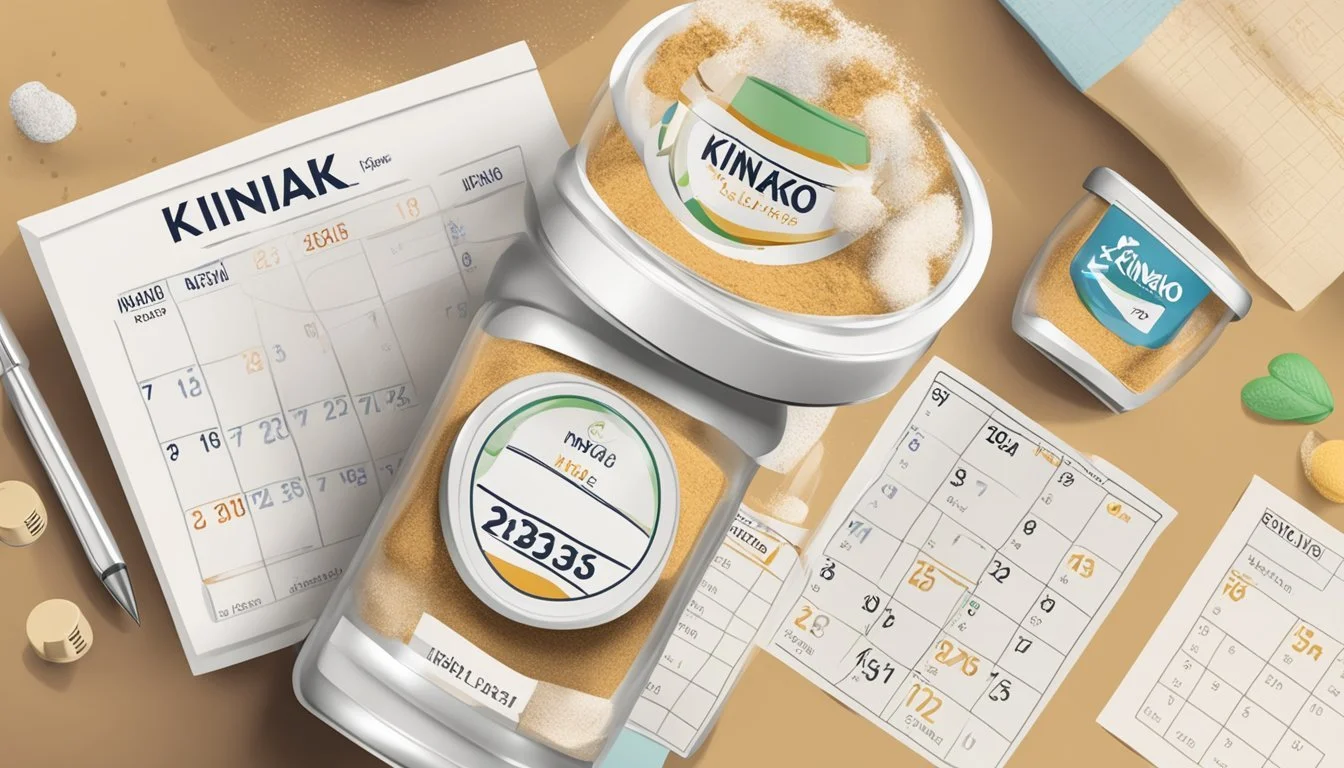How Long Does Kinako Last?
Shelf Life and Storage Tips
Kinako, a roasted soybean flour, is a staple in Japanese cuisine known for its nutty flavor and versatility in various dishes, particularly sweets. It bears a golden-yellow hue and offers several health benefits owing to its high protein content. Like many flour-based products, kinako has a shelf life that consumers should be aware of to ensure quality and flavor are preserved.
The shelf life of kinako can be influenced by several factors, including the way it is stored and the environment it is kept in. The flour's delicate nature means it is prone to oxidation and can become rancid if exposed to air, light, or heat for prolonged periods. Proper storage, ideally in a cool, dark, and airtight container, can significantly extend its freshness.
Understanding how long kinako lasts and recognizing the signs of spoilage are important for maintaining safety in its consumption and ensuring the desired taste profile of the dishes it is used in. Consumers are advised to check the "best by" date when purchasing and to conduct sensory evaluations, such as smell and taste tests, before use if the kinako has been stored for an extended period.
What Is Kinako?
Kinako is a traditional Japanese ingredient derived from soybeans. It is essentially roasted soybean flour, known for its distinctive golden-yellow color and nutty taste. In Japan, kinako is not only prized for its flavor but also for its versatility in various dishes.
The production process involves:
Selecting quality soybeans.
Carefully drying them.
Roasting to achieve the desired flavor.
Grinding the roasted soybeans into a fine flour.
The resulting powder boasts a variety of uses in Japanese cuisine. It’s a key condiment sprinkled over sweets such as mochi, warabi mochi, dango, and ohagi.
Nutritional Profile: Kinako is favored for its nutritional benefits as it’s a source of protein and dietary fiber.
Textural Element: Its fine texture allows it to blend well with other ingredients without altering the desired consistency of the final dish.
Culinary Uses: Apart from traditional sweets, kinako finds its way into contemporary recipes like lattes, as a topping on toast, or even transformed into spreads as a substitute for nut butters.
In summary, kinako's unique characteristics and nutritional properties make it an integral part of both classic and modern Japanese gastronomy.
Nutritional Profile
Kinako, or roasted soybean flour, emerges as a remarkable gluten-free food with an impressive nutritional profile. It is a derivative of soybeans and, as such, shares many of the nutritional benefits inherent to the soybean itself. Akin to other soy products, kinako is laden with protein, making it a particularly suitable option for those seeking plant-based protein sources.
Protein Content
By dry weight, kinako packs more protein per 100g than many meat products, emphasizing its potential as a protein-rich supplement for both meat-eaters and vegetarians alike.
Fiber and Minerals
In terms of dietary fiber, kinako provides a substantial amount, which contributes to digestive health. This roasted soybean flour is also a treasure trove of essential minerals such as calcium for bone health, iron crucial for oxygen transportation in the blood, magnesium, which plays a role in numerous biochemical reactions, and potassium that supports heart function.
Isoflavones and Vitamins
Additionally, kinako contains soy isoflavones, phytochemicals considered to provide several health benefits, including support for bone health. While it isn't a significant source of vitamins, it compensates with its mineral-rich composition and health-promoting isoflavones.
It's the fusion of these nutrients that makes kinako a nutritious addition to a well-rounded diet, particularly for those with gluten sensitivities or allergies as it offers an alternative to traditional flour. Thus, kinako is not only a versatile ingredient but also a supportive element in maintaining a healthy lifestyle.
Usage in Japanese Cuisine
Kinako, roasted soybean flour, features prominently in the pantheon of flavors for traditional Japanese desserts and modern culinary applications. Its versatility and nutty flavor make it a staple ingredient that transcends generations and cooking styles.
Traditional Japanese Desserts
Kinako is an integral component of Japan’s dessert repertoire. It is traditionally used as a topping or a coating for a variety of Japanese sweets like mochi and dango. Kinako mochi, which is mochi dusted with kinako, offers a warm, toasty contrast to the soft, chewy rice cake. Warabi mochi, not made from rice but from bracken starch, is another confection commonly rolled in kinako. Similarly, ohagi, sweet rice balls coated with bean paste, also enjoy a kinako variant. This flour is not only about allure but functionality, as it prevents stickiness and enhances the taste.
Wagashi, the collective term for traditional Japanese confections, frequently embraces kinako for its ability to complement sweetness. These desserts are often paired with green tea, highlighting the contrast and balance between the bitter tea and the sweet, nutty kinako flavor.
Modern Uses in Cooking
Aside from its traditional use, kinako has adapted to modern culinary trends, adding dimension to various baked goods and beverages. In some Japanese grocery stores and cafes, kinako-flavored ice cream, lattes, and shakes provide a contemporary twist on classic profiles.
Adventurous chefs and home cooks alike sprinkle kinako on shaved ice, assimilating its rich flavor with the refreshing treat. Recipes for bread and other baked products may incorporate kinako to introduce a distinctly Japanese twist. The incorporation of this ingredient in such a wide array of dishes demonstrates its flexibility and growing popularity in both home and restaurant settings.
Kinako as an Ingredient
Kinako, a roasted soybean flour, is notable for its nutty flavor and versatile use in various recipes, acting as a key component for a range of desserts and confections. This ingredient adds a distinctively warm, nutty taste and a soft, light texture to culinary creations.
Complementary Ingredients and Flavors
When using kinako in recipes, it pairs well with sugar to enhance sweetness, and it's often used alongside ingredients like milk, yogurt, and cinnamon. It complements the flavors in chocolate and works well with brown sugar to create a depth of flavor in desserts. Its flavor profile also allows it to blend seamlessly with honey, bananas, or kuromitsu, a Japanese sugar syrup. Kinako's light and powdery texture improves the mouthfeel in cakes, cookies, and especially in daifuku, a traditional Japanese mochi dessert. It can even be sprinkled on a simple bowl of yogurt to add a toasty twist.
Substitutes and Alternatives
Should a recipe call for kinako but it’s unavailable, certain alternatives may be used. All-purpose flour combined with peanut butter can mimic kinako's consistency and nuttiness, albeit with a heavier texture. Potato starch can serve as a substitute in terms of texture but lacks the distinct nutty taste. In some cases, toasted and ground nuts, such as hazelnuts or almonds, may act as alternatives, offering a similarly nutty flavor that complements the other ingredients in a recipe. However, while substitutes can provide similar textures or flavors, the unique taste of kinako is difficult to replicate entirely.
Storage and Shelf Life
When storing homemade kinako, which is roasted soybean flour, maintain its freshness by keeping it in an airtight container. This precaution is essential to prevent moisture and air from affecting the quality. An airtight seal ensures that the kinako remains dry and free from contaminants.
The ideal storage location for kinako is in a cool, dark place at room temperature. These conditions help preserve its nutty flavor and toasty aroma. If stored properly, kinako can last several months. However, for prolonged shelf life, refrigeration is recommended. When refrigerated, kinako can last even longer—up to a year.
For those who wish to keep kinako beyond this time, freezing is an option. Ensure the flour is wrapped securely in plastic wrap before placing it in a freezer-safe airtight container. Freezing can extend kinako's shelf life significantly.
The table below outlines the expected shelf life of kinako under various storage conditions:
Storage Condition Expected Shelf Life Room Temperature Several Months Refrigerator Up to 1 Year Freezer Extended Period
In conclusion, selecting the right storage method is crucial. Opt for an airtight container at room temperature for short-term use, utilize the refrigerator for an annual scope, or freeze if one needs to preserve kinako for an extended period.
Making Kinako at Home
When preparing kinako, a traditional Japanese flour, at home, it's important to focus on the roasting process for flavor development and to store the flour properly to maintain its quality.
Homemade Kinako Process
To make kinako at home, one begins by roasting yellow soybeans. This process is critical as it develops kinako's distinctive nutty flavor. The roasting should be done in a preheated oven, typically at 350°F (175°C), for 10 to 12 minutes. One must watch the soybeans closely since oven temperatures can vary.
After roasting, the soybeans should have a golden brown color, and their fragrance will be noticeably nuttier. It's then necessary to cool the beans to room temperature. Once cooled, they are ground to a fine powder using a coffee grinder or a similar appliance. The result is a fine, yellow, nutty-smelling flour known as kinako.
Storage Tips for Homemade Kinako
Proper storage of kinako extends its shelf life and preserves its flavor. Homemade kinako should be stored in an airtight container to prevent moisture absorption and to keep it fresh. The container must be kept in a cool, dark place, such as a cupboard or pantry.
For longer storage periods, placing the airtight container in the refrigerator is advisable, as this can help to maintain its quality for several months. Due to kinako's low-carb properties, it is often used as an alternative to regular flour in various dishes, which makes proper storage even more significant for those relying on it for dietary purposes.
Health Considerations
When discussing the shelf life of kinako, it's important to consider its nutritional content and how storage might affect its health benefits. Kinako is nutritious, offering a source of plant-based protein—beneficial for vegetarians and vegans. Its fiber content is notable and contributes to gastrointestinal health, while the presence of soy isoflavones links it to potential improvements in bone health.
Storing kinako properly is key to maintaining its health advantages:
Airtight Container: Preserves freshness and extends shelf life.
Cool, Dry Place: Prevents the degradation of nutrients.
Nutrient Benefit Protein Supports muscle health and repair Fiber Aids digestive health Isoflavones May enhance bone density and reduce hot flashes in postmenopausal women
Additionally, kinako is inherently gluten-free, making it a suitable choice for those with gluten sensitivities or celiac disease. However, consumers should verify that the kinako they purchase is free from cross-contamination if gluten is a concern.
Ultimately, while kinako can have a long shelf life, its health benefits—such as contributions to bone health through soy isoflavones and general nutritional value from protein and fiber—are best preserved through proper storage. Individuals can enjoy the advantages of this wholesome supplement without compromising its qualities when stored correctly.
Purchasing Kinako
When looking for kinako, buyers have a couple of main avenues to consider. They can purchase it either online or in local Japanese grocery stores. The flour typically appears as a yellow flour and is derived from roasted soybeans. Occasionally, it's made from black soybeans, which may offer a slightly different flavor profile.
Online Shopping
When purchasing kinako online, consumers should:
Check for freshness indicators, such as "best by" dates.
Research reputable vendors for quality assurance.
Look for reviews to gauge previous buyers’ satisfaction.
Japanese Grocery Stores
For those who prefer in-person shopping, Japanese grocery stores generally stock kinako. Buyers should:
Inspect the packaging to ensure it is sealed and intact.
Opt for stores with higher product turnover to increase the likelihood of acquiring fresher kinako.
Kinako is sold in various sizes, so consumers should consider their needs before buying. Smaller quantities are advisable for those who use it sparingly to ensure the flour doesn’t expire before it's fully used.
Storage notes: Regardless of the purchase method, ensure that kinako is stored in a cool, dry place to preserve its longevity. Direct sunlight or moisture can negatively affect the product's shelf life and flavor.
Incorporating Kinako in Western Dishes
When venturing beyond traditional Japanese recipes, kinako can readily infuse its distinctive nutty flavor into Western cuisine. Chefs and home cooks alike are finding inventive ways to blend this roasted soybean flour into their dishes, from breakfast to snacks.
Baked Goods and Breakfasts
Kinako's versatility shines in baked goods, bringing a boost of protein alongside its unique taste. Cookies can take on a novel flavor profile by substituting a portion of regular flour with kinako, and its slightly sweet, toasty note pairs exceptionally with buttered toast. However, one should ensure not to overwhelm the primary taste of delicate pastries. The incorporation of kinako into oatmeal or dusted atop French toast offers a delightful twist on morning favorites, with the flour's nuttiness complementing the natural warmth of these dishes.
Snacks and Beverages
For a quick and nutritious snack, kinako can be mixed into smoothies to add depth and a protein punch. When sprinkled on top, it creates a layer of flavor complexity that enhances the beverage without overpowering it. This flour can also be used to create an array of snacks from granola bars to nutrition-packed energy bites. For a comforting and wholesome snack, a sprinkle of kinako over warm milk creates a soothing, subtly flavored drink.
FAQs and Tips
How long does kinako (roasted soybean flour) last?
Kinako typically lasts for several months when stored in a cool, dry place. If sealed and kept away from moisture and heat, it can maintain its quality for up to 6 months.
Can kinako be frozen to extend its shelf life?
Yes, freezing kinako can extend its shelf life. One should store it in an airtight container or a heavy-duty freezer bag to prevent moisture from affecting the texture.
Does microwaving affect kinako?
Microwaving kinako is not recommended as it could alter its nutty flavor and texture. Use kinako as a finishing powder or incorporate it into the dough without microwaving.
What is the best way to maintain kinako's texture?
To maintain its powdery texture, keep kinako in an airtight container and avoid exposure to dampness. Moisture can cause it to clump or spoil.
Are there any tips for using kinako in dough or recipes?
When adding kinako to dough or recipes, one should thoroughly mix it to ensure an even distribution of flavor. Kinako can replace up to 25% of flour in a recipe to impart its unique taste without compromising the dough's structure.
How should kinako be used?
Best used as a finishing touch, sprinkle kinako on sweet dishes like mochi or incorporate it into dessert recipes for an added nutty flavor. Kinako works well as a thickener for sauces and can be used to create nut-free spreads.












